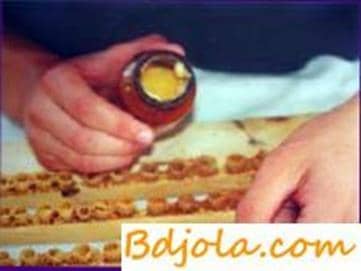
Beekeepers from the time of Aristotle were interested in the question of why the queen bee, which emerged from the same egg as all bees, is almost twice as long and heavier than the worker bees, has the amazing ability to store a colossal number of eggs (up to 2,000 or more per day) , lives about 6 years, and her daughter – worker bees-only 30-35 days. To solve this mystery of nature helped the success of chemistry.
The egg intended for withdrawal of the uterus, the bees are placed in a special waxy cell of the acorn-shaped form, into the so-called motherhood, and supply the larva with a special food – royal jelly. The mother liquor at this time can be compared with a wax keg, where the larva of the future uterus literally floats in a creamy mass. This is royal jelly, a jelly-like mass of milky color with a pearl shade.
In many countries it is called “royal jelly”.
Natural milk contains up to 18% of proteinaceous substances, 10 to 17% of sugar, up to 5.5% of fat and more than 1% of mineral salts. Royal jelly is rich in vitamins B1, B2, B3, B6, Bc, B12, PP, N. Vitamins C, A (carotene) and D in it is small, and according to some researchers, absolutely none.
Royal jelly is produced by the glands (pharyngeal, maxillary and secret allotro-phical) bees-nurses in the same way as milk of mammals is excreted by the mammary gland.
Bacteriological studies have established that native royal jelly in the mother liquor – a natural container – is not only sterile, but also has antibiotic properties. It is clear that these facts led researchers and clinicians to pay attention to these amazing properties of royal jelly, which soon became known as a superfood, a wonderful medicine of the 20th century. Royal jelly has been widely recommended not only as a remedy for internal diseases, but also as a geriatric and cosmetic.
Какая пчелы зимует лучше. Гоголь моголь с медом.
Royal Jelly